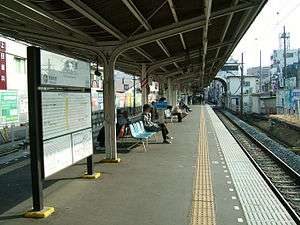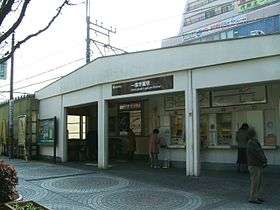Hitotsubashi-Gakuen Station
Hitotsubashi-Gakuen Station (一橋学園駅, Hitotsubashi-Gakuen eki) is a railway station in Kodaira, Tokyo, Japan.
ST02 Hitotsubashi-Gakuen Station 一橋学園駅 | |
|---|---|
 Platforms of Hitotsubashi-Gakuen Station | |
| Location | 2-1-1 Gakuen-nishi-cho, Kodaira, Tokyo (東京都小平市学園西町二丁目1-1) Japan |
| Operated by | |
| Line(s) | |
| Platforms | 1 island platform |
| Other information | |
| Station code | ST02 |
| History | |
| Opened | 1928 |
| Traffic | |
| Passengers (FY2014) | 20,481 daily |

Lines
Hitotsubashi-Gakuen Station is served by the 9.2 km Seibu Tamako Line from Kokubunji in Kokubunji, Tokyo to Seibu-Yūenchi in Higashimurayama, Tokyo. It is located 2.4 kilometers from the terminus of the line at Kokubunji Station.
Station layout
The station has a single island platform on a north-south axis, serving two ground-level tracks. The Seibu Tamako Line is single-track most of its length, and dual track at Histotsubashi-gauken Station is used to allow trains travelling in opposite directions to pass each other. Thus, a train arriving in the station will wait at the platform for a train to stop at the opposite platform before departure. The station has entrances-exits at both ends of the platform (North and South). Passengers are able to cross to the platform island by means of small level crossings after the automatic ticket wicket gates. Passengers then climb steps (south) or a ramp (north) to platform level.
History
Hitotsubashi-Gauken Station opened on April 6, 1928, when the track between Kodaira and Kokubunji, via Hagiyama was opened, which is now part of the Seibu Tamako Line.
Station numbering was introduced on all Seibu Railway lines during fiscal 2012, with Hitotsubashi-Gauken Station becoming "ST02".[1]
Passenger Statistics
In fiscal 2014, the station was the 50th busiest on the Seibu network with an average of 20,481 passengers daily.[2] The passenger figures for previous years are as shown below.
| Fiscal year | Daily average |
|---|---|
| 2009 | 20,667[3] |
| 2010 | 20,218[3] |
| 2011 | 19,546[4] |
| 2012 | 20,151[5] |
| 2013 | 20,363[6] |
References
- 西武線全駅で駅ナンバリングを導入します [Station numbering to be introduced at all Seibu stations] (PDF). News Release (in Japanese). Japan: Seibu Railway. 23 February 2012. Archived from the original (PDF) on 2015-09-24. Retrieved 2 April 2013.
- 駅別乗降人員 2014(平成26)年度 1日平均 [Average daily station usage figures (fiscal 2014)] (PDF) (in Japanese). Japan: Seibu Railway. Archived from the original (PDF) on 8 March 2016. Retrieved 17 May 2016.
- 駅別乗降人員 2010(平成22)年度 1日平均 [Average daily station usage figures (fiscal 2010)] (PDF) (in Japanese). Japan: Seibu Railway. Archived from the original (PDF) on 26 June 2011. Retrieved 17 November 2013.
- 駅別乗降人員 2011(平成23)年度 1日平均 [Average daily station usage figures (fiscal 2011)] (PDF) (in Japanese). Japan: Seibu Railway. Archived from the original (PDF) on 1 November 2012. Retrieved 17 November 2013.
- 駅別乗降人員 (2012年度1日平均) [Average daily station usage figures (fiscal 2012)] (PDF) (in Japanese). Japan: Seibu Railway. Archived from the original (PDF) on 10 September 2013. Retrieved 17 November 2013.
- 駅別乗降人員 (2013年度1日平均) [Average daily station usage figures (fiscal 2013)] (PDF) (in Japanese). Japan: Seibu Railway. Archived from the original (PDF) on 14 July 2014. Retrieved 18 August 2014.